In the last decade, peony farms in Alaska have increased tenfold. According to the latest Census of Agriculture, there were 100 peony farms in the state.
The growth has been propelled by headlines like these: Alaska’s peonies are the state’s new cash crop, ‘The industry’s about to explode’: Peony market flourishes in Alaska, Alaskan peony farmers aim to grow industry, and How Alaska became a center of peony cultivation.
Credit for the boom also goes to UAF Professor Pat Holloway who, 20 years ago, made it known that, because Alaska peonies bloomed at a time when they weren’t available anywhere else in the world–during the height of the wedding season–they could garner premium prices.
Notwithstanding the ebullient headlines, are Alaska’s peony farmers flourishing? Are they making money? That’s what I wanted to find out when I interviewed over a dozen farmers in Interior Alaska.
David Russelll is the president of the Alaska Peony Growers Association (no longer active), and owner of one the largest peony farms in Alaska. He likens peony farming to a video game. The first level is growing marketable peonies, the second, chilling and post-harvest handling, and the third, marketing. Each level presents new challenges and unknowns. If you successfully reach the third level, you must continue juggling all of the challenges of the first and second levels as well.
Three farmers I interviewed did not make it past the first level — growing marketable peonies. Mike Quinn, a small peony grower (300 roots) ran into problems with the variety he planted. He explained that there are very strict parameters of what the industry will buy and sell. “I bought a variety that grew well but it didn’t produce a thick enough stem, and it didn’t grow the bomb flower. . .The only place I can sell them is the farmers market.”
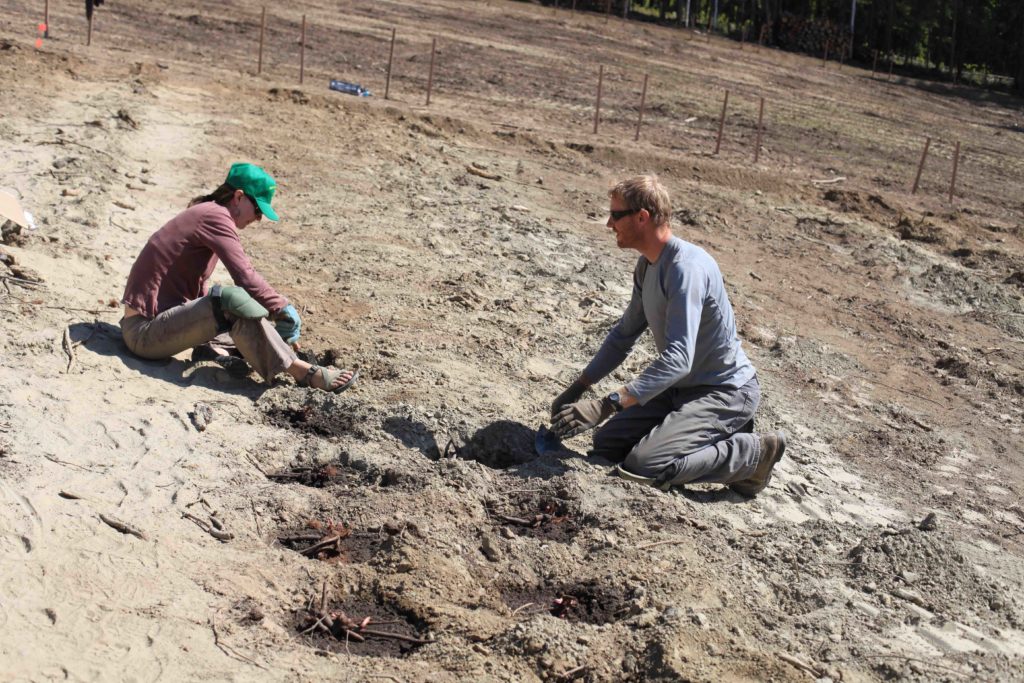
Here I am planting peony roots at Far North Flowers, with Nate Heeringa, who owns the farm with my sister, Krista. Photo by Krista Heeringa.
Quinn said he would have continued to expand if he could have gotten $2 or $3 a stem. On the other hand, he said even if it was paying some money, he’s not sure it’s how he wants to spend his retirement. The peonies needed to be harvested at the same time he likes to fish for king salmon.
Kathy Frizzera (300 roots) had no delusions about how hard peony farming would be, owing to the fact that her grandparents were large farmers in Kansas. Her original goal was to plant 5,000 roots, but she is bowing out due to her age and health, family dynamics, insufficient capital and lack of fertile soil. She has enough energy to do her day job, but not to grow peonies on top of that.
After investing about $5,000 and six years of work, she sold one bucket of peonies. For Kathy, the silver lining was that she has met some truly wonderful people. “The cooperation has enabled the industry to get as far as it has today. Whether or not it fails or succeeds, I hope that cooperation will remain in spite of competitiveness.” She said she would do it again if she was in her 40s but on a small piece of land detached from her house so that the herbicides and pesticides wouldn’t impact the health of her family, pets or future homeowners.
Another farmer who asked not to be identified, planted 900 roots and invested five years of work only to have to relocate due to a job change before selling any stems. She did not think the peony roots resulted in any additional revenue when she sold her house.
Russell, with the help of extended family, has played all three levels of peony game, but not without some unpleasant surprises. He had been told to expect 10 marketable stems per plant after three to five years. Perhaps his soils were too cold or his pH is too acidic, but after six years he only harvested an average of seven stems per plant. This means a smaller and more delayed return on investment, which in his case is significant at 17,000 roots.
Even those who, due to a combination of luck and fastidiousness, create optimal growing conditions for the plants, still have no control over when the peonies bloom. Fairbanks growers are finding the late summer niche unreliable. In fact, in 2019, it disappeared.
Ron Illingworth (13,000 roots), one of the first peony farmers in the state and a champion for the industry, said farmers in Fairbanks finished harvesting by July 2 this year. This was before the upper Midwest stopped harvesting. It’s news to no one that the vagaries of weather make farming difficult, but in The Atlantic, UAF Assistant Professor Nancy Fresco explained that warming trends might make the niche a thing of the past.
The second level of the metaphorical peony farming videogame is post-harvest handling and chilling. While the Dutch may not be harvesting peonies in mid- or late-summer they’ve mastered the techniques of chilling them longer, allowing them to tap into Alaska’s so-called exclusive niche. Plus, their farms are paragons of efficiency so they can sell their stems profitably at prices far below Alaska farmers.
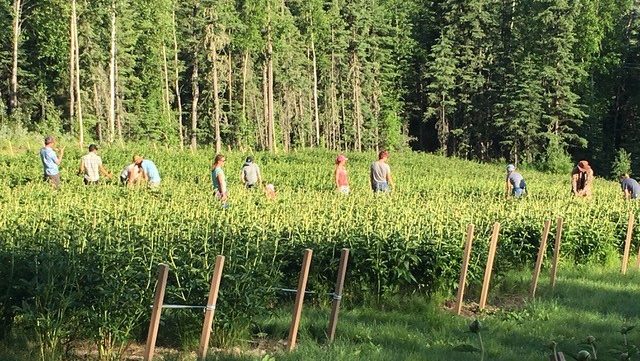
It can take a village to harvest peonies at just the right time. The 2019 harvest period was compressed due to the record heat. Photo by Maggi Rader.
Carolyn Chapin started one of the first peony farms in Alaska (and in Fairbanks) in 2003 (with Jan Hanscom). She explained that originally the late summer niche was there. “We were selling to high-end markets to meet summer demands. When we first started shipping in 2004, the Dutch were done right after Mother’s Day. . .With a very strong summer demand, the Dutch are pushing further into it by storing their stems much longer than previously, and they are expanding peony production. Even though Alaska peonies are months fresher during summer, buyers are looking at a price point and are waiting until they can’t get the cheaper imported stems anymore. So now ours have stored to wait out the Dutch availability and so are also 4-6 weeks old, or older when sold. The niche markets are still there but they’re harder to come by.” Even though their flowers may not be as fresh, big, or even open if businesses or brides are looking at the bottom line, they often opt for the cheaper option.
The third level and, by most accounts, the least fun part of the difficult game of peony farming is selling the peonies. The farmers I talked to did not go into peony farming because they liked marketing and sales, but because they wanted to be outside growing flowers. Naomi Brodersen, who has farmed with her family since 2014 (1,400 roots), describes what’s involved. From January to May or June until they started harvesting, her sister and her boyfriend contacted 300-400 florists.
“It’s time-consuming,” she said. They googled wedding destinations and picked a city and contacted florists. Then they had a template they’d send to florists, then people would come back with questions.
The Arctic Alaska Peony Cooperative in Fairbanks was supposed to relieve farmers of this chore, but they disbanded in the fall of 2019. For a couple years, Chapin, marketed for 14 peony farms (this is called a packhouse) in Fairbanks but cut back to three farms because she wasn’t making enough money for the amount of work involved. If growers are lucky enough to have a packhouse or co-op to work with, they must fork over 20 to 60% of gross sales–more if they’re paying for cold storage and marketing, less if they’re just paying for marketing.
Working with a packhouse or co-op can add inconvenience to the process as well. Ideally, stems should be chilled right after they’re cut. For small growers like Quinn it was particularly inconvenient. Ideally, stems should be chilled right after being harvested, but since the nearest chiller was 30 miles, it was very time-consuming to transport the stems during the harvest–the busiest time of year for growers.
And it’s not just selling all of the stems, it’s selling them at a profitable price. There’s an often repeated story about a buyer in London who wanted to buy 100,000 peonies every week of the summer from the University of Alaska Fairbanks Georgeson Botanical Garden, which at the time, only produced a handful of stems. What isn’t always mentioned is that the buyer only wanted to pay 50 cents per stem (page 13 of this report). By conflating high, wholesale demand with high retail prices ($4, $5, $6 or more), it’s been easy to imagine making bank as a peony farmer!
Markets change quickly and vary with supply, bloom time and quality. One seller might get a better price than another seller due to their product quality, number of stems and varieties available, reliability, connections, marketing prowess and their hutzpah. An Interior peony grower and packhouse owner, who asked not to be identified, described prices, size and special requirements of various markets in 2019 (see the table below). Although anecdotal, it’s valuable because it is current.
| Market Type | Price range per stem | Size of Order (No. of stems) | Other Notes |
|---|---|---|---|
| Direct sales to brides | $4-6 | 25-50 | Highest prices but not repeat buyers and very time consuming |
| Direct sales to florists | $4-6 | 25-200 | High prices but small and inconsistent orders |
| Wholesalers | $3-$3.75 $2.60 - $3 | 500-1,000 1,000 – 3,000 | Small weekly orders Large weekly orders |
| Bouquet makers | $2.60-$3.25 | 1,000-3,000 | |
| Mass market | $1.75 - $2 | 2,000-4,000 | Grocery stores. Large weekly orders. They often require bundles of 3 and bar-coded sleeves. Most Alaskans are not set up for bar-coding. Not many Alaskans sell in mass markets |
| Mass market – sub premium stems | $1 - $1.5 | Small buds and short stems |
Older research papers described markets in 2012. Current prices topped out at $6 a stem compared with a high of $10 in 2012. Wholesale prices dropped from $4-4.50 in 2012 to $2.60-$3.75 in 2019, depending on the size of the order.
With an unreliable niche and no co-op, can Fairbanks peony growers make money? None of the farmers I talked to were, even those who’d been at it more than a decade. Most were covering their annual costs, including hired labor but not their own time. Quinn weighed in, “I think a good percentage of people are continuing to get into this business thinking there is money to be made. It’s possible, but the question is, is it likely? If you’d gotten into this business 10 years ago it might have been likely, but I don’t think it is today. The whole area has stuck their neck out, the big buyers know that everybody here is over a barrel. And they’ve either got to deal with a low price [at the coop] or do their own marketing.”
Chapin, who used to teach the growers school for the Annual Alaska Peony Conference said, “Jan and I have always said plan on $2 a stem. Some people are planning around $5 a stem. Some don’t care so they’re selling for $2.10. Once wholesalers get it at that price, then they won’t pay more.”
That’s where the coop came in. They were supposed to ensure everyone got a fair, high price, while maintaining quality and accessing some of the larger export markets. The final payout from the Arctic Alaska Peony Cooperative was less than a dollar a stem.
Kim Herning (5,000 roots), helped market for the Arctic Alaska Peony Cooperative and also served on its board. She said, “I’ve always felt my hands were tied because I was associated with AAPC and coming down from the president, everything had to be positive. But that’s not realistic. That’s not really a good gauge of how the industry is doing. If you are putting everything in a positive light, that’s not really fair to people jumping into it.” Herning said, “Had we known those things, we would have done things differently or maybe we wouldn’t have done it at all. It’s not fair to new farmers. If someone is really seriously thinking about starting a farm. They need as much information as they can get.”
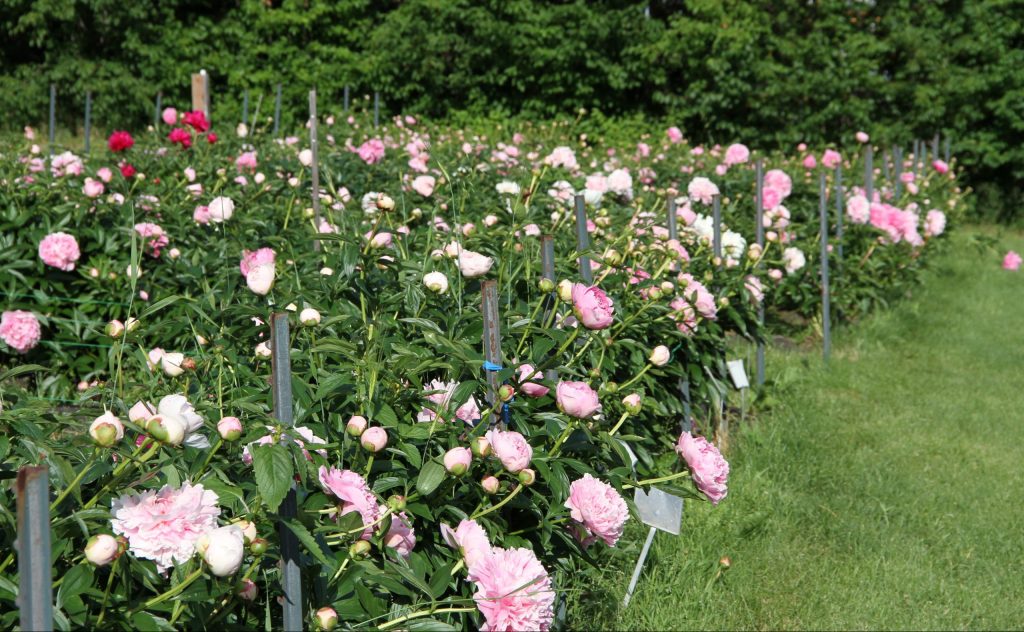
Peony trials began in Alaska at the Georgeson Botanical Garden.The flowers continue to delight visitors.
Looking back, Brodersen said, “I wish we would have had a more realistic picture of what the peony industry would be. Everyone had an idealistic view of what the prices would be and how many stems per plant you would get. … We thought all we would have to do was the growing. We thought we would bring our stems to the co-op and they would cut us a check and we wouldn’t have to do all the boxing and shipping. … Overall it’s turned out to be a whole lot more work than what we expected and having to do all the different aspects and the prices are much lower than what we hoped for.”
Although the peony industry has grown and continues to grow thanks to the efforts of passionate, hard-working individuals and state and federal money, it does not portend to the success of individual growers. In the absence of a cooperative marketing or selling entity, the growth could be its detriment. A larger industry means more competition, especially at a local level. Those dabbling in peony growing pose a risk to the reputation of Alaska-grown peonies if they sell substandard buds or undercut other growers. As an aside, the support industry (suppliers, service providers, researchers, and educators) has benefited from the growth of the industry, particularly through grant funding.
I wish it wasn’t so, but as with any type of farming, it’s hard for small-farmers to compete with agriculture juggernauts. Lacking a solid niche, that’s what small Alaska peony farmers are doing. More discussion and research should be done on what kind of peony farm is most likely to be profitable in Alaska — including size, location, and marketing strategy. The come one, come all mentality has afforded the industry a welcoming and cooperative vibe, but it may be time to acknowledge that growing peonies in Alaska is a serious undertaking which may not be profitable on a small or even medium scale.
Pros and cons of a larger industry aside, potential growers should not be seduced into starting a peony farm for the good of the whole by sugarcoating the risk-reward ratio. As Kim Herning puts it, they should have full access to the “good, bad, and the ugly.”
Before you start a peony farm, here are some things to consider. . .
Before you take the plunge, make sure you know what you’re getting into. Lease or work at a peony farm. Go behind the scenes to appreciate the time commitment, physical demands, stress, frequency and toxicity of commonly-used pesticides (this was a deal-breaker for some of the farmers I talked to), start-up and annual costs, post-harvest requirements, the marketing rigmarole, and, of course, the joys, too. For some, working outside in a field of flowers and making people smile is reward enough.
Chapin explained, “There’s all these complex moving pieces, it’s like a jet engine. . . . but people are looking at it like it’s a bicycle.”
Brodersen had a romantic notion of peony farming. Although parts of it are like that, she said there were a lot of hard aspects, particularly the business side of things (including marketing) that she hadn’t considered.
Brodersen said would-be peony farmers should think about their goals — is it going to be a hobby or sole occupation? “And then I would really try to get across how much work it was,” she said. “It’s a product people expect to be perfect. Just having a product that’s perishable and delicate, there’s a lot that goes into it.”
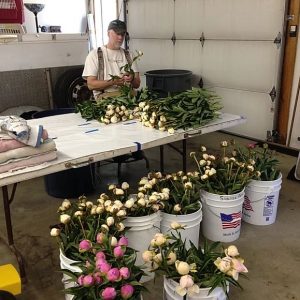
Kelvin Brodersen grades peonies. Photo by Naomi Brodersen.
“There’s a checklist — the stem has to be straight, the side buds have to be removed,” she said. “Flower management–getting them in the chiller quick enough. A little bit of mold can grow while they’re in the chiller. All the things that factor into dealing with something perishable that people are paying a high price for. I didn’t consider those things. Making sure people understand that and the hours and hours of work that go into it. You kind of need to have all the skills. You need to be a solid farmer, a business person, and (do the) shipping and boxing, and marketing.”
Russell, reminds people that you have to wait at least five years for your plants to mature, then after that, “You are going gangbusters all summer every summer. Unless you go into this with a long-term business mindset, you will begin to resent the long summer hours spent in the field and not dip-netting, fishing in Valdez or hiking in the mountains — all the other reasons people live in Alaska. This is not an endeavor that allows you to take a summer off. On the other hand, there is nothing more special than watching your, and your family’s, hard work turn into a thriving, blossoming business.”
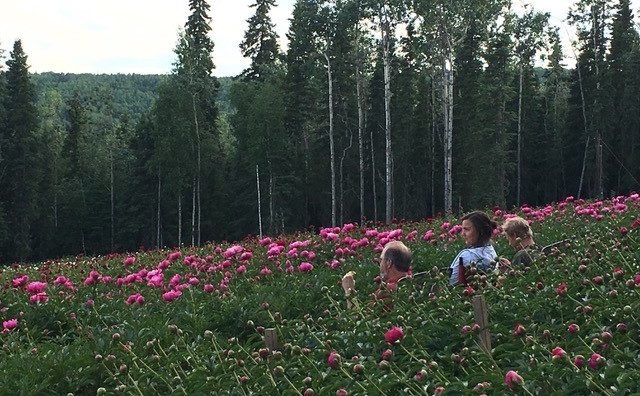
A peony farm is a beautiful place to work and enjoy at the end
of the day. Photo by Maggi Rader.
Writing a realistic business plan and pinning down your break-even price per stem is an essential first step. RightRisk developed the Enterprise Risk Analyzer Tool to help you identify your break-even price.
Ko Klaver, the president of Botanical Trading Company and advisor for the cut flower industry, thinks Alaska farmers’ break-even price averages around $2.22 per stem and most would be happy to be paid $2.75-$3.25 or more, wholesale. Klaver thought the break-even price for European farmers was about 55 cents a stem and said, “they would be tickled pink to get more than a euro a stem (USD $1.11).” In a translated article from the Royal Flower Holland Auction, Klaver noted that in July 2019 (July is when availability overlaps with Interior Alaska), the average price was 46 cents per stem.
Chapin, said you should figure on getting $2 a stem. Hanscom said you should plan on only $1 per stem if you don’t do everything yourself. Brodersen thought that they would be happy with $3 per stem, if they could’ve just dropped the stems off at the co-op (and not done the boxing and shipping). You also need to factor in that you won’t sell 100% of your stems, a co-op or packhouse could take a 20-60% cut and wholesalers sometimes require you to pay shipping. In Alaska, peonies do sell for higher prices than elsewhere.
The Census of Agriculture reports detailed data on peony farms with sales of $100,000 or more, and in 2018 there was one in Alaska. Half of its stems (25,000) were sold at an average wholesale price of $3.25 per stem. Gross sales for this farm were calculated to be $163,000. This seems like a good indication that this farm is not only profiting but prospering. This stem price was more than twice as high as any other state. Colorado saw the lowest wholesale price at 64 cents per stem while California had the highest at $1.61 per stem. Statewide, in 2017, total cut flower and cut florist greens sales from 100 farms (probably mostly peony farms) was $940,683.
Russell wouldn’t discourage new peony farmers. He said, “For new farmers, there is a tremendous opportunity in peonies. You have to look at it realistically. What level do I need to get into it? What level do I want to invest? If you want to have 500 plants and you have a couple boutiques in New York that will give you $6 a stem, that’s perfect.”
But it’s not uncommon for buyers to back out, even at the last minute. Ron Illingworth who was president of Arctic Alaska Peonies co-op, said he anticipated a big sale to grocery stores. “Well he (the buyer) changed his mind in late June and we’d already purchased everything we needed and were harvesting at the time, and we ended up not being able to sell about 10,000 stems.” This figured into why the co-op dissolved this fall.
Klaver said that ideally, you want to lock in 80% of your sales contracts before the season starts. But he said when supply is high, buyers tend to be looser on their contracts and it can be hard to lock them in. Klaver showed that from 2014 to 2018, the number of stems produced in Holland more than doubled from 70 to 166 million–a massive supply increase. If availability overlaps, like it does in July, then there is direct competition with the Dutch-grown peonies in Alaska.
Marketing is a challenge for many. Brodersen said, “The marketing is the big hard one. Just putting yourself out there and talking to hundreds of florists and trying to sell yourself. That’s not something that comes naturally to me.”

Coral Charms demand the highest peony prices but can’t be grown in colder microclimates in the Interior.
In The Lean Farm, Ben Hartman encourages growers to test the market thoroughly and not to push a product on customers. He says “the customer alone defines value” and that, just because a farmer wants to produce something, doesn’t mean the customer wants to buy it. Klaver said high quality standards must be maintained and to remember, “You are only as good as your last delivery.”
Hanscom thinks that this statewide problem needs a statewide solution. “What Alaska needs is a brokerage that will sell every single stem we have,” she said. “And we don’t have that.”
Kim Herning (5,000 roots), who helped market for the now dissolved Arctic Alaska Peony co-op, thinks there needs to be a statewide marketing effort comparable to the Alaska Seafood Marketing Institute. She doubts that will happen with the current budget pressures.
Adding peonies to an existing farm also could be a great strategy. It provides diversification and the initial investment is lower if you already own arable land. This worked well for Mary Ver Hoef, who added peonies to her diversified (mostly organic but not certified) farm.
She took advantage of the less stringent demands of the farmers market to sell short-stemmed peonies, which she can harvest more of without sacrificing the future vigor and productivity of her plants. Other markets require straight, 24-inch stems, which take a bigger toll on plants. She also sells at the Co-op Market, provides flowers for local weddings and offers a subscription service.
Ver Hoef sees peonies as a wonderful opportunity and just wishes that she had started younger. At one point Ver Hoef had as many as 500 plants. Now she’s down to 84 peonies after selling quite a few plants at the farmers market for a profit. Even so, she’d like to spend less time farming and more time on her family’s boat and enjoying Alaska summers. She’s looking for someone who might be interested in leasing her field.
In addition to selling the stems, there are lots of side hustles to consider. You could offer agritourism and workshops, provide a wedding and event venue or conduct research on your farm. Floret Flower Farm in Washington does many of these things well and there are also great examples in Alaska. But these activities are an additional time commitment during the busy summer season.
Kim Herning has been thinking about doing workshops and events, “But then I think I’m already so busy in the summer and I’m exhausted, how am I going to have the energy to develop other things? Do I really want to overextend myself?”
Peony farmers in Interior Alaska have had a spectrum of experiences and the reasons for starting and stopping are numerous. Many farms are still new and have yet to realize their full potential. If you do start a peony farm, you stand to benefit tremendously from the substantial amount of research done and lessons learned by those who took the plunge first.
I only interviewed peony farmers from the Fairbanks area so this is an Interior-centric blog post. Other regions have some of the same, but also very different challenges and opportunities. This post was previously published as two articles in the Fairbanks Daily Newsminer on February 2 & 16, 2020
Excellent article. It addresses all of the questions left unstated in the frustrating puff pieces I have read in Alaska newspapers over the past decade. Thank you for your research, interviews and links to documents.
How do state agricultural agencies deal with failing farms? Grants, loans, cost sharing, and equipment. Has the trough run dry?